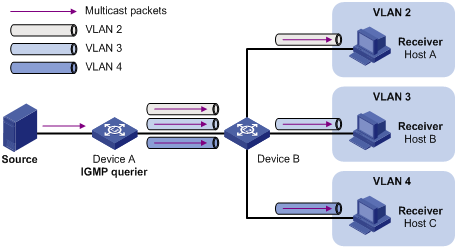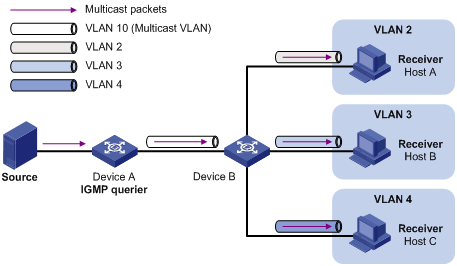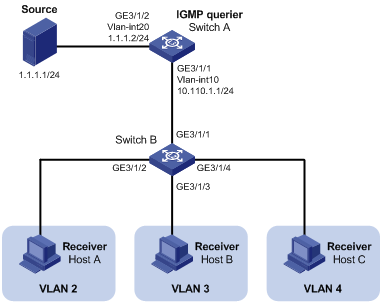- Table of Contents
-
- 08-IP Multicast Configuration Guide
- 00-Preface
- 01-Multicast overview
- 02-IGMP snooping configuration
- 03-PIM snooping configuration
- 04-Multicast VLAN configuration
- 05-Multicast routing and forwarding configuration
- 06-IGMP configuration
- 07-PIM configuration
- 08-MSDP configuration
- 09-Multicast VPN configuration
- 10-MLD snooping configuration
- 11-IPv6 PIM snooping configuration
- 12-IPv6 multicast VLAN configuration
- 13-IPv6 multicast routing and forwarding configuration
- 14-MLD configuration
- 15-IPv6 PIM configuration
- Related Documents
-
| Title | Size | Download |
|---|---|---|
| 04-Multicast VLAN configuration | 93.71 KB |
Restrictions: Hardware compatibility with multicast VLAN
Restrictions and guidelines: Multicast VLAN configuration
Configuring a sub-VLAN-based multicast VLAN
Setting the maximum number of multicast VLAN forwarding entries
Display and maintenance commands for multicast VLAN
Multicast VLAN configuration examples
Example: Configuring sub-VLAN-based multicast VLAN
Configuring multicast VLANs
Multicast VLAN function
As shown in Figure 1, Host A, Host B, and Host C are in three different VLANs and the same multicast group. When Device A (Layer 3 device) receives multicast data for that group, it sends three copies of the multicast data to Device B (Layer 2 device). This occupies a large amount of bandwidth and increases the burden on the Layer 3 device.
Figure 1 Multicast transmission without the multicast VLAN feature

After a multicast VLAN is configured on Device B, Device A sends only one copy of the multicast data to the multicast VLAN on Device B. This method saves network bandwidth and lessens the burden on the Layer 3 device.
Multicast VLAN methods
Multicast VLAN is implemented based on sub-VLANs.
Sub-VLAN-based multicast VLAN
As shown in Figure 2:
· Host A, Host B, and Host C are in VLAN 2 through VLAN 4, respectively.
· On Device B, VLAN 10 is a multicast VLAN. VLAN 2 through VLAN 4 are sub-VLANs of VLAN 10.
· IGMP snooping is enabled for the multicast VLAN and its sub-VLANs.
Figure 2 Sub-VLAN-based multicast VLAN

IGMP snooping manages router ports in the multicast VLAN and member ports in each sub-VLAN. When Device A receives multicast data from the multicast source, it sends only one copy of the multicast data to the multicast VLAN on Device B. Then, Device B sends a separate copy to each sub-VLAN in the multicast VLAN.
Restrictions: Hardware compatibility with multicast VLAN
Multicast VLAN is supported only on the CSPC-GE16XP4L-E, CSPC-GE24L-E, and CSPC-GP24GE8XP2L-E cards, CSPEX cards, and CEPC cards.
Restrictions and guidelines: Multicast VLAN configuration
The VLAN to be configured as a multicast VLAN must exist.
You can configure only one multicast VLAN.
Do not configure a multicast VLAN on a device that is enabled with IP multicast routing. Otherwise, the system displays errors. Do not enable IP multicast routing on a device that is configured with multicast VLANs. Otherwise, multicast forwarding exceptions occur.
Do not configure a VLAN as a multicast VLAN or a multicast sub-VLAN if the VLAN interface is enabled with PIM or IGMP. Otherwise, the system displays errors. Do not enable PIM or IGMP on a VLAN interface if the VLAN interface belongs to a multicast VLAN or a multicast sub-VLAN. Otherwise, multicast forwarding exceptions occur.
Configuring a sub-VLAN-based multicast VLAN
Restrictions and guidelines
The VLANs to be configured as sub-VLANs of a multicast VLAN must exist and cannot be multicast VLANs or sub-VLANs of any other multicast VLAN.
Prerequisites
Before you configure a sub-VLAN-based multicast VLAN, you must complete the following tasks:
· Create VLANs as required.
· Enable IGMP snooping for the VLAN to be configured as the multicast VLAN and for the VLANs to be configured as sub-VLANs.
Procedure
1. Enter system view.
system-view
2. Configure a VLAN as a multicast VLAN and enter multicast VLAN view.
multicast-vlan vlan-id
By default, a VLAN is not a multicast VLAN.
3. Assign VLANs to the multicast VLAN as sub-VLANs.
subvlan vlan-list
Setting the maximum number of multicast VLAN forwarding entries
About setting the maximum number of multicast VLAN forwarding entries
You can set the maximum number of multicast VLAN forwarding entries on the device. When the upper limit is reached, the device does not create multicast VLAN forwarding entries until some entries age out or are manually removed.
Procedure
1. Enter system view.
system-view
2. Set the maximum number of multicast VLAN forwarding entries.
multicast-vlan entry-limit limit
By default, the maximum number of multicast VLAN forwarding entries is 1024.
Display and maintenance commands for multicast VLAN
Execute display commands in any view and reset commands in user view.
|
Command |
|
|
Display information about multicast VLANs. |
display multicast-vlan [ vlan-id ] |
|
(In standalone mode.) Display information about multicast groups in multicast VLANs. |
display multicast-vlan group [ source-address | group-address | slot slot-number | verbose | vlan vlan-id ] * |
|
(In IRF mode.) Display information about multicast groups in multicast VLANs. |
display multicast-vlan group [ source-address | group-address | chassis chassis-number slot slot-number | verbose | vlan vlan-id ] * |
|
(In standalone mode.) Display information about multicast VLAN forwarding entries. |
display multicast-vlan forwarding-table [ group-address [ mask { mask-length | mask } ] | source-address [ mask { mask-length | mask } ] | slot slot-number | subvlan vlan-id | vlan vlan-id ] * |
|
(In IRF mode.) Display information about multicast VLAN forwarding entries. |
display multicast-vlan forwarding-table [ group-address [ mask { mask-length | mask } ] | source-address [ mask { mask-length | mask } ] | chassis chassis-number slot slot-number | subvlan vlan-id | vlan vlan-id ] * |
|
Clear multicast groups in multicast VLANs. |
reset multicast-vlan group [ source-address [ mask { mask-length | mask } ] | group-address [ mask { mask-length | mask } ] | vlan vlan-id ] * |
Multicast VLAN configuration examples
Example: Configuring sub-VLAN-based multicast VLAN
Network configuration
As shown in Figure 3:
· Layer 3 device Device A runs IGMPv2 and acts as the IGMP querier. Layer 2 device Device B runs IGMPv2 snooping.
· The multicast source sends multicast data to multicast group 224.1.1.1. Receivers Host A, Host B, and Host C belong to VLAN 2, VLAN 3, and VLAN 4, respectively.
Configure a sub-VLAN-based multicast VLAN on Device B to meet the following requirements:
· Device A sends the multicast data to Device B through the multicast VLAN.
· Device B forwards the multicast data to the receivers in different user VLANs.

Procedure
1. Configure Device A:
# Enable IP multicast routing.
<DeviceA> system-view
[DeviceA] multicast routing
[DeviceA-mrib] quit
# Create VLAN 20, and assign GigabitEthernet 3/1/2 to the VLAN.
[DeviceA] vlan 20
[DeviceA-vlan20] port gigabitethernet 3/1/2
[DeviceA-vlan20] quit
# Assign an IP address to VLAN-interface 20, and enable PIM-DM on the interface.
[DeviceA] interface vlan-interface 20
[DeviceA-Vlan-interface20] ip address 1.1.1.2 24
[DeviceA-Vlan-interface20] pim dm
[DeviceA-Vlan-interface20] quit
# Create VLAN 10.
[DeviceA] vlan 10
[DeviceA-vlan10] quit
# Configure GigabitEthernet 3/1/1 as a hybrid port, and assign the port to VLAN 10 as a tagged VLAN member.
[DeviceA] interface gigabitethernet 3/1/1
[DeviceA-GigabitEthernet3/1/1] port link-type hybrid
[DeviceA-GigabitEthernet3/1/1] port hybrid vlan 10 tagged
[DeviceA-GigabitEthernet3/1/1] quit
# Assign an IP address to VLAN-interface 10, and enable IGMP on the interface.
[DeviceA] interface vlan-interface 10
[DeviceA-Vlan-interface10] ip address 10.110.1.1 24
[DeviceA-Vlan-interface10] igmp enable
[DeviceA-Vlan-interface10] quit
2. Configure Device B:
# Enable IGMP snooping globally.
<DeviceB> system-view
[DeviceB] igmp-snooping
[DeviceB-igmp-snooping] quit
# Create VLAN 2, assign GigabitEthernet 3/1/2 to the VLAN, and enable IGMP snooping for the VLAN.
[DeviceB] vlan 2
[DeviceB-vlan2] port gigabitethernet 3/1/2
[DeviceB-vlan2] igmp-snooping enable
[DeviceB-vlan2] quit
# Create VLAN 3, assign GigabitEthernet 3/1/3 to the VLAN, and enable IGMP snooping in the VLAN.
[DeviceB] vlan 3
[DeviceB-vlan3] port gigabitethernet 3/1/3
[DeviceB-vlan3] igmp-snooping enable
[DeviceB-vlan3] quit
# Create VLAN 4, assign GigabitEthernet 3/1/4 to the VLAN, and enable IGMP snooping in the VLAN.
[DeviceB] vlan 4
[DeviceB-vlan4] port gigabitethernet 3/1/4
[DeviceB-vlan4] igmp-snooping enable
[DeviceB-vlan4] quit
# Create VLAN 10, and enable IGMP snooping for the VLAN.
[DeviceB] vlan 10
[DeviceB-vlan10] igmp-snooping enable
[DeviceB-vlan10] quit
# Configure GigabitEthernet 3/1/1 as a hybrid port, and assign the port to VLAN 10 as a tagged VLAN member.
[DeviceB] interface gigabitethernet 3/1/1
[DeviceB-GigabitEthernet3/1/1] port link-type hybrid
[DeviceB-GigabitEthernet3/1/1] port hybrid vlan 10 tagged
[DeviceB-GigabitEthernet3/1/1] quit
# Configure VLAN 10 as a multicast VLAN, and assign VLAN 2 through VLAN 4 as sub-VLANs to multicast VLAN 10.
[DeviceB] multicast-vlan 10
[DeviceB-mvlan-10] subvlan 2 to 4
[DeviceB-mvlan-10] quit
Verifying the configuration
# Display information about all multicast VLANs on Device B.
[DeviceB] display multicast-vlan
Total 1 multicast VLANs.
Multicast VLAN 10:
Sub-VLAN list(3 in total):
2-4
# Display information about multicast groups in multicast VLANs on Device B.
[DeviceB] display multicast-vlan group
Total 1 entries.
Multicast VLAN 10: Total 1 entries.
(0.0.0.0, 224.1.1.1)
Sub-VLANs (3 in total):
VLAN 2
VLAN 3
VLAN 4
The output shows that multicast group 224.1.1.1 belongs to multicast VLAN 10. Multicast VLAN 10 contains sub-VLANs VLAN 2 through VLAN 4. Device B will replicate the multicast data of VLAN 10 to VLAN 2 through VLAN 4.
